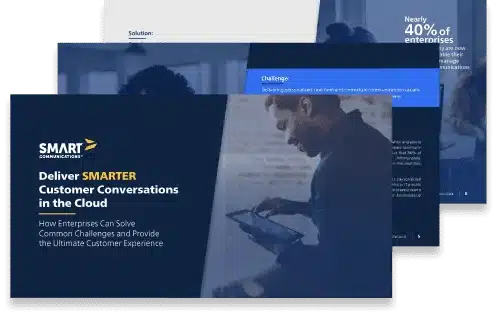The Future of Workers’ Compensation
By: Ruth Fisk, VP Insurance Strategy at Smart Communications
A digital-first approach streamlines every stage of the claims lifecycle and leads to improved outcomes for all.
Introduction: Digitizing the Workers’ Compensation Claims Experience
When a worker is injured on the job, the employer’s first concern is their well-being. Additional considerations include ensuring the employee has a swift recovery, minimizing the personal fallout and mitigating future risks. Beyond that, employers also have to take into consideration the wider impact of workers’ compensation claims, to the business as a whole as well as to the ecosystem of involved parties that can be affected when an injured worker is unable to do their job. In addition to medical expenses and employee compensation, disruptions to productivity and continuity can strain resources within the company and impact the bottom line. The ripple effects can even reach the wider economy and society, making it all the more critical to focus on facilitating a rapid recovery. Employers have a vested interest in ensuring the employee regains their health and returns to work as soon as is feasible.
Workers’ compensation insurers are equally focused on supporting a timely and complete recovery for any claimant who is injured on the job. Resolving claims as quickly and efficiently as possible not only helps to minimize long-term impacts on the individual, it also helps the insurer minimize the financial impact. Reporting delays can increase costs as well as increasing anxiety and confusion for the claimant. In some cases, it can even lead to unnecessary litigation—an outcome all involved parties would prefer to avoid.
In today’s world, digitizing the workers’ compensation claims experience plays a crucial role in improving processes and outcomes for insurers, employers and injured workers. By automating manual, paper-based tasks, insurers can streamline every step of the claims management lifecycle and engage smarter with everyone from the injured employee to the rehabilitation specialist. But, this requires the right cloud-first solution.
To transform processes and deliver better outcomes, insurance organizations must adopt digital-first solutions and take a conversation-based approach. Moving to a dynamic, cloud-based customer communications platform makes every step of the workers’ compensation claims management process more efficient, from initial reporting through final payout and case closure. And with a single platform facilitating the multitude of forms and documents required in this highly-regulated space, case managers can keep both the recovery and resolution on track for faster results.
Let’s look at how the right solution can streamline and improve each stage of the workers’ compensation claims lifecycle, bringing outdated processes into the future.
Stage 1: Reporting the Injury
The first step of any workers’ compensation injury claim is reporting. During this critical stage, time is of the essence. It’s important for insurers to educate employees about their responsibility to report an injury as soon as possible. Faster reporting helps to accelerate the return-to-work process, reducing costs for both insurer and employer. In addition, injury reporting may be subject to government regulation, depending on the location. Failure to report an injury within a set timeframe may result in fines and other liabilities. A cloud-based solution can accelerate reporting by streamlining communications between the injured employee, the insurer and the employer.
Collect
A digital-first solution makes the claims intake process frictionless by collecting information using intelligent, adaptive forms, which are much more efficient than traditional paper-based processes. Integrating with core systems of record, insurers can pre-populate forms with company and policy information, making it easier for the employer to report the injury in a timely manner. The insurer can also use guided interactive forms to kick off the initial First Report of an Injury (FROI) assessment by guiding the employer through all of the initial claims data required related to the injury, ultimately providing a frictionless experience and expediting reporting.
Communicate
A modern solution should automatically generate any communications required by regulatory bodies, ensuring compliance. This includes exchanges between the injured worker, employer, case worker, medical provider and rehabilitation specialist, all of which are managed by the insurer. For example, an intelligent solution can create the FROI acknowledgment letter and provide the injured worker with a list of approved or preferred medical providers. It can facilitate more efficient occupational safety reviews.
Stage 2: Investigating the Claim
Next, claims are assigned to a case manager inside the insurance company. This person is responsible for gathering details from multiple involved parties, creating an accident summary, reviewing the material and photographic evidence and recommending preventative measures to reduce future loss. All of this needs to be done as efficiently and effectively as possible. An intelligent digital platform makes it easier for the case manager to carry out their responsibilities in a timely manner while also maintaining compliance.
RELATED READING | ‘Modernizing the Workers’ Compensation Claims Process’
Collect
Gathering additional material evidence from witnesses can be expedited by using adaptive forms that also allow for the easy inclusion of photographic evidence. Dynamic forms that are available on-demand allow for convenience and can even guide witnesses through the process.
Coordinate
If insurers don’t have an individual’s channel preference on record already, this is information they can collect early on. It’s important to ensure all future interactions are delivered on the user’s channel of choice, whether that’s email, mobile app, SMS or something else entirely. An omnichannel experience – where the individual can move from one channel to another without losing any historical context – is only possible with a cloud-native solution. Ultimately, an omnichannel experience helps to expedite the claims process and also provides a frictionless experience.
Collaborate
In a workers’ compensation claim, there are multiple stakeholders – both within and outside the insurance organization. As the case manager quarterbacks the end-to-end claims experience, working within a centralized, online environment makes it easier to get everyone to agree on what happened so the case can move forward. Plus, it mitigates version control issues and ensures all parties are working from the most recent documentation. Most importantly, however, digitized collaboration among all parties mitigates running into the regulatory or compliance issues that analog, manual processes can create.
Communicate
The case manager is also responsible for creating key documentation to be put into the case file and shared with involved parties. A smart solution streamlines and automates these critical processes, such as creating the accident summary after reviewing all the collected evidence. Case documentation is also subject to strict government body regulation, and automation can help to ensure compliance—unlike manual communications, which are tedious and error-prone.
Stage 3: Medical Management
In this stage of a claim, the medical provider is assessing the injury and establishing a treatment plan to facilitate the worker’s recovery. This includes things like evaluating if they need in-home help, rehabilitation and/or physical therapy. Depending on the details of the claim and the nature of the injury, medical management can involve any number of parties, making collaboration and communication vital.
Collaborate
Workers’ compensation insurers often have a medical officer who is responsible for liaising with physicians, rehabilitation specialists and other medical providers to determine the best possible treatment plan. The medical officer will review the injured employee’s medical records and may use evidence-based medicine to recommend procedures. For example, in the case of a slip-and-fall injury, they could review the insurer’s data for similar injuries to see where the insurer has had the most success expediting the return-to-work process.
The case worker, medical officer and providers must work together to establish a treatment plan and return-to-work date as soon as is feasible for the injured worker. Streamlining collaboration through a centralized, online hub helps to expedite this process to the benefit of the worker, the employer and the insurer.
Communicate
The medical officer and case manager also need to be able to easily and clearly share information with all involved parties. Injury details and medical records must be shared with the physician. Once established, the treatment plan needs to be shared with the injured worker so they can follow the prescribed treatment. A certificate of capacity may be issued, allowing the employee to return to work with certain restrictions.
Sharing the return-to-work date with the worker will help to alleviate emotional stress and anxiety due to loss of work and income. At the same time, knowing what they are working towards can be a motivating factor on the path to recovery. From the employer’s perspective, knowing the expected return-to-work timeline will help them allocate resources and plan accordingly.
Digitizing the workers’ compensation claims experience helps to streamline and expedite investigation processes and creates consistency across stakeholders, allowing for an interactive experience. A solution that enables omnichannel conversations gives the case manager the added advantage of being able to guide any involved individual to the most appropriate channel for a specific interaction, with seamless switching to maintain consistency.
Stage 4: Case Management
Once the treatment plan has been established, the insurer is focused on creating the best possible outcomes—for both the worker and the employer. The case manager and medical officer both need to be able to communicate, collaborate and coordinate efforts across all involved parties to facilitate these desired outcomes.
Collaborate
Determining the best way forward for the injured worker requires collaboration on many levels. The case manager and medical officer work with the claimant to help them create a self-determination plan, which is empowering and improves life outcomes in both the short- and long-term. They also need to work closely with physicians, rehabilitation specialists and other medical providers to ensure the employee’s recovery stays on track so they can return to work as expected.
If a specialist is needed to train the injured worker for a new job or for their return to work, the case manager will also need to create a rehabilitation plan. Connecting the injured worker with support groups can be beneficial in aiding a full recovery and alleviating emotional stress or anxiety. A centralized, cloud-based platform makes it easy for the case manager and medical officer to fulfill all of these responsibilities and keep track of multiple moving parts without letting anything slip between the cracks.
Communicate
It’s important to keep the lines of communication open throughout the claims lifecycle. The case manager needs to be in regular contact with the injured employee to ensure they are following prescribed treatment plans. And, the injured worker needs to be able to initiate conversations with the claims manager at their convenience, to ask questions and to make sure they’re getting the support they need.
A digitized, omnichannel solution allows for easy, seamless conversations on demand. Automating appointment reminders not only saves the case manager time for improved productivity, it also helps to keep recovery on track and on schedule – contributing to better outcomes overall.
Coordinate
During the ongoing case management stage, insurers must orchestrate communications between various involved parties and update back-end core systems, such as the claims handling system, to determine the best next steps. A purpose-built platform simplifies complexity and can even automatically update backend systems for a seamless flow of information.
Stage 5: Settlement
The final stage of the workers’ compensation claims process entails finalizing any remaining payments, establishing a return-to-work release and managing any long-term benefits. All of this needs to be completed before the insurer can close out the case.
Collaborate
The case manager must make sure all injury-related expenses are paid for, including medical invoices, drug prescriptions and other treatment costs. If the injured worker needs long-term care, payouts must be made to cover future expenses. And in the event that the injury resulted in death, the insurer is responsible for managing survivor death benefits. Centralizing all of these required steps makes it easier to close the case out in a timely manner while satisfying all policy and regulatory requirements.
Communicate
At this final stage, the ultimate goal is to establish a return-to-work authorization that determines when and where the injured employee can go back to work and share it with both the employee and employer. Digitizing communications makes this process more efficient.
Coordinate
To effectively close out the case, the case manager must orchestrate any final communications between involved parties and update the core systems. With a single, centralized hub that integrates with existing systems, the insurer has on-demand access to a comprehensive repository of all claims-related information and communications. This makes it easier to ensure regulatory compliance and helps to facilitate a complete recovery and get the claimant back to work sooner.
The Conversation CloudTM: Designed to Drive Better Outcomes
When it comes to digitizing the workers’ compensation claims experience, the Conversation Cloud enables insurers to turn static forms and disparate communications into dynamic, on-demand conversations across the claims management lifecycle. By using a pure cloud solution that integrates seamlessly with existing systems, insurers can dramatically simplify processes, expedite decisions, facilitate faster resolution and create better outcomes for everyone.
With the Conversation Cloud, insurers can prepopulate forms to personalize interactions and boost case manager productivity while also keeping claimant recovery on track. Additional capabilities include:
- Harness the power of smarter automation to improve communications, maintain compliance and enhance the claims experience.
- Integrate with core claims management systems such as Guidewire ClaimCenter, Duck Creek Claims and Sapiens ClaimsPro, enabling elements of straight-through processing and improving the user experiences for case managers.
- Infuse intelligence into every step, from sentiment detection to built-in compliance, for SMARTER engagement from start to finish.
Digitizing the Workers’ Compensation Claims Experience Starts Now
Workers’ compensation claims can have a widespread impact—on the individual employee, the employer’s business and even the wider economy. Adopting a digital-first approach and replacing one-way interactions with intelligent, two-way conversations helps workers’ compensation insurers increase case manager productivity, reduce costs and deliver a modern experience that everyone involved will appreciate.
Expediting resolution and infusing ease and efficiency into every step of the claims management process improves outcomes for all involved parties, while also:
- Streamlining work and managing costs for the insurer.
- Supporting faster recovery for the injured worker, resulting in less emotional and financial stress and better life outcomes.
- Mitigating productivity and future losses for the employer.
It’s time to digitize the workers’ compensation claims experience with a modern solution and a conversation-based approach.
—
To find out how the Smart Communications Conversation Cloud can help your business drive better workers’ compensation claims outcomes, contact us today.
Or, check out some additional resources about digitizing the workers’ compensation claims experience:
- Modernizing the Workers’ Compensation Claims Process
- The Workers’ Compensation Case Manager of Tomorrow
- Reimagining the Workers’ Compensation Process for Today’s Digital World
- Driving Better Outcomes for Workers’ Compensation (coming soon!)



